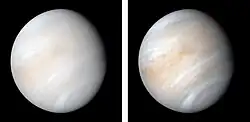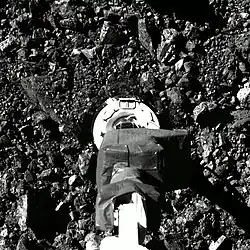2020 PN1
| Discovery | |
|---|---|
| Discovered by | ATLAS-HKO |
| Discovery site | Haleakalā Observatory |
| Discovery date | 12 August 2020 |
| Designations | |
Designation | 2020 PN1 |
| Orbital characteristics[2][3][4] | |
| Epoch 31 May 2020 (JD 2459000.5) | |
| Uncertainty parameter 0 | |
| Observation arc | 361 days |
| Aphelion | 1.12482093 AU |
| Perihelion | 0.8713906 AU |
| 0.998105754 AU | |
| Eccentricity | 0.1269557 |
| 1.00 y (364.219560 d) | |
| 32.06964° | |
| Inclination | 4.80807° |
| 145.63610° | |
| 55.40365° | |
| Earth MOID | 0.0248258 AU |
| Physical characteristics | |
| Dimensions | 10–50 m[a][5] |
| 25.5[2] | |
2020 PN1 is a sub-kilometer asteroid, classified as a near-Earth object of the Aten group, that is a temporary horseshoe companion to the Earth. There are dozens of known Earth horseshoe librators, some of which switch periodically between the quasi-satellite and the horseshoe co-orbital states.[6]
Discovery
2020 PN1 was discovered on 12 August 2020 by L. Denneau, J. Tonry, A. Heinze, and H. Weiland observing for the ATLAS-HKO Survey.[7] As of 20 January 2021, it has been observed 41 times with an observation arc of 361 days.[2]
Orbit and orbital evolution
2020 PN1 is currently an Aten asteroid (Earth-crossing but with a period less than a year). Its semi-major axis (currently 0.998105754 AU) is similar to that of Earth (0.999789 AU), but it has a moderate eccentricity (0.1269557) and low orbital inclination (4.80807°). It alternates between being an Aten asteroid and being an Apollo asteroid, although its orbital evolution is not fully stable and it can be considered as a temporary co-orbital companion to the Earth.[6]
Physical properties
With an absolute magnitude of 25.5 mag, it has a diameter in the range of 10–50 meters (for an assumed albedo range of 0.04–0.20, respectively).
Exploration
2020 PN1 was pre-selected for an exploration by a Chinese mission of planetary defense including an impactor and a separate orbiter planned to launch in 2026.[8] However, in April 2023, the new target is 2019 VL5.[9]
See also
Notes
- ^ This is assuming an albedo of 0.20–0.04.
References
- ^ List Of Aten Minor Planets
- ^ a b c d 2020 PN1 at the JPL Small-Body Database Retrieved 2021-01-20
- ^ AstDys-2 on 2020 PN1 Retrieved 2021-01-20
- ^ NEODyS-2 on 2020 PN1 Retrieved 2021-01-20
- ^ Absolute-magnitude conversion table (H)
- ^ a b de la Fuente Marcos, Carlos; de la Fuente Marcos, Raúl (March 2021). "Using Mars co-orbitals to estimate the importance of rotation-induced YORP break-up events in Earth co-orbital space". Monthly Notices of the Royal Astronomical Society. 501 (4): 6007–6025. arXiv:2101.02563. Bibcode:2021MNRAS.501.6007D. doi:10.1093/mnras/stab062.
- ^ Discovery MPEC
- ^ Andrew Jones (12 July 2022). "China to target near-Earth object 2020 PN1 for asteroid deflection mission". SpaceNews. Retrieved 29 September 2022.
- ^ Andrew Jones (11 April 2023). "China to target asteroid 2019 VL5 for 2025 planetary defense test". SpaceNews. Retrieved 21 April 2023.
- Further reading
- Bottke, William F.; Jedicke, Robert; Morbidelli, Alessandro; Petit, Jean-Marc; Gladman, Brett (June 2000). "Understanding the Distribution of Near-Earth Asteroids". Science. 288 (5474): 2190–2194. Bibcode:2000Sci...288.2190B. doi:10.1126/science.288.5474.2190. ISSN 0036-8075. PMID 10864864.
- Christou, Apostolos A. (March 2000). "A Numerical Survey of Transient Co-orbitals of the Terrestrial Planets". Icarus. 144 (1): 1–20. Bibcode:2000Icar..144....1C. doi:10.1006/icar.1999.6278.
- Bottke, William F.; Morbidelli, Alessandro; Jedicke, Robert; Petit, Jean-Marc; Levison, Harold F.; Michel, Patrick; Metcalfe, Travis S. (April 2002). "Debiased Orbital and Absolute Magnitude Distribution of the Near-Earth Objects". Icarus. 156 (2): 399–433. Bibcode:2002Icar..156..399B. doi:10.1006/icar.2001.6788. ISSN 0019-1035.
- Brasser, R.; Innanen, K. A.; Connors, M.; Veillet, C.; Wiegert, P.; Mikkola, Seppo; Chodas, P. W. (September 2004). "Transient co-orbital asteroids". Icarus. 171 (1): 102–109. Bibcode:2004Icar..171..102B. doi:10.1016/j.icarus.2004.04.019. ISSN 0019-1035.
- de la Fuente Marcos, C.; de la Fuente Marcos, R. (April 2016). "A trio of horseshoes: past, present and future dynamical evolution of Earth co-orbital asteroids 2015 XX169, 2015 YA and 2015 YQ1". Astrophysics and Space Science. 361 (4) 121. arXiv:1603.02415. Bibcode:2016Ap&SS.361..121D. doi:10.1007/s10509-016-2711-6. ISSN 0004-640X.
External links
- Discovery MPEC
- 2020 PN1 data at MPC
- 2020 PN1 at NeoDyS-2, Near Earth Objects—Dynamic Site
- 2020 PN1 at ESA–space situational awareness
- 2020 PN1 at the JPL Small-Body Database


_on_Jul_14_2020_aligned_to_stars.jpg)